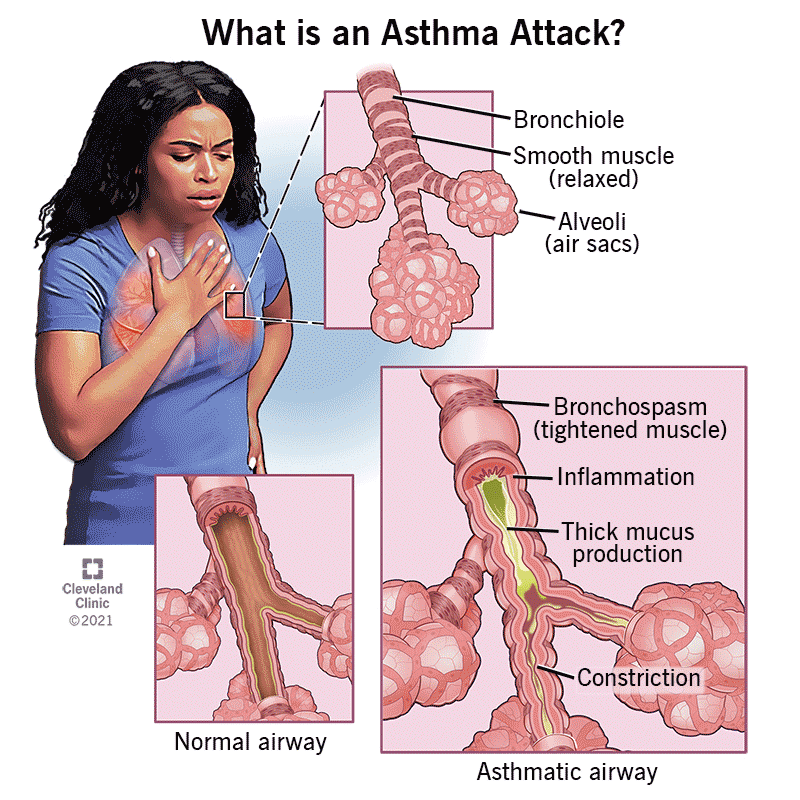Which of the following would the nurse discuss as common triggers for a client newly diagnosed with asthma? (SELECT ALL THAT APPLY)
Exercise
Pollen
Animal dander
Emotional stress
Recent travel abroad
Correct Answer : A,B,C,D
Choice A reason:
Exercise is a well-known trigger for asthma, particularly exercise-induced bronchoconstriction (EIB). During physical activity, especially in cold or dry air, the airways can narrow, leading to symptoms such as shortness of breath, wheezing, and coughing. Proper management and pre-exercise medication can help mitigate these effects.
Choice B reason:
Pollen is a common allergen that can trigger asthma symptoms. Pollen from trees, grasses, and weeds can cause allergic reactions that lead to asthma exacerbations. Seasonal variations in pollen levels can significantly impact individuals with asthma, making it important to monitor pollen counts and take preventive measures.
Choice C reason:
Animal dander, which consists of tiny flakes of skin shed by cats, dogs, and other animals, is a frequent asthma trigger. Proteins found in the dander, saliva, and urine of pets can cause allergic reactions and asthma symptoms. Reducing exposure to pets and maintaining a clean environment can help manage this trigger.
Choice D reason:
Emotional stress can also trigger asthma symptoms. Stress and strong emotions can lead to hyperventilation and changes in breathing patterns, which can exacerbate asthma. Stress management techniques and relaxation exercises can be beneficial in controlling asthma symptoms related to emotional stress.
Choice E reason:
Recent travel abroad is not typically considered a common trigger for asthma. While travel can expose individuals to different environmental factors and allergens, it is not a direct trigger like the other options listed. However, it is important for individuals with asthma to plan and prepare for travel to manage their condition effectively.

Nursing Test Bank
Naxlex Comprehensive Predictor Exams
Related Questions
Correct Answer is B
Explanation
Choice A reason:
Pulse oximetry is 90% is not an ideal indicator of effective treatment. A normal pulse oximetry reading is typically between 95% and 100%. A reading of 90% suggests that the patient may still be experiencing hypoxemia, which indicates that the pneumonia may not be fully resolved.
Choice B reason:
White blood cell count is 9000/µL is a strong indicator that the treatment has been effective. A normal white blood cell (WBC) count ranges from 4,000 to 11,000/µL. An elevated WBC count is often seen in infections, and a return to normal levels suggests that the infection is resolving.
Choice C reason:
Bronchial breath sounds heard at the right base are not typically a sign of improvement. These sounds can indicate consolidation or fluid in the lungs, which are common in pneumonia. Effective treatment should result in the reduction of abnormal breath sounds.
Choice D reason:
Sputum that is light yellow in color does not necessarily indicate effective treatment. While a change in sputum color can be a sign of improvement, it is not as reliable as other clinical indicators such as WBC count or improvement in symptoms
Correct Answer is A
Explanation
Clients on tuberculosis (TB) medications, particularly those on isoniazid, rifampin, and pyrazinamide, are at risk for hepatotoxicity. Therefore, regular monitoring of liver function tests (LFTs) is crucial to detect any liver damage early and adjust treatment as necessary.
Choice A reason:
Liver function studies are essential for clients on TB medications. Drugs like isoniazid, rifampin, and pyrazinamide can cause liver toxicity. Monitoring liver enzymes such as ALT (alanine aminotransferase) and AST (aspartate aminotransferase) helps in early detection of hepatotoxicity, allowing for timely intervention to prevent severe liver damage. Regular LFTs ensure that any adverse effects on the liver are identified and managed promptly.
Choice B reason:
White blood cells (WBCs) are not typically monitored monthly for clients on TB medications. While WBC counts can be affected by various conditions and treatments, they are not specifically indicative of the side effects of TB medications. Monitoring WBCs might be necessary if there are signs of infection or other hematologic issues, but it is not a standard monthly requirement for TB treatment.
Choice C reason:
Coagulation studies are not routinely required for clients on TB medications. These tests are more relevant for patients on anticoagulant therapy or those with bleeding disorders. TB medications do not typically affect coagulation parameters, so regular monitoring of coagulation studies is not necessary unless there is a specific clinical indication.
Choice D reason:
Red blood cells (RBCs) are also not typically monitored monthly for clients on TB medications. While anemia can occur in TB patients, it is not a direct side effect of the medications used to treat TB. Monitoring RBCs might be necessary if there are symptoms of anemia or other hematologic concerns, but it is not a standard part of monthly TB treatment monitoring.
Whether you are a student looking to ace your exams or a practicing nurse seeking to enhance your expertise , our nursing education contents will empower you with the confidence and competence to make a difference in the lives of patients and become a respected leader in the healthcare field.
Visit Naxlex, invest in your future and unlock endless possibilities with our unparalleled nursing education contents today
Report Wrong Answer on the Current Question
Do you disagree with the answer? If yes, what is your expected answer? Explain.
Kindly be descriptive with the issue you are facing.
